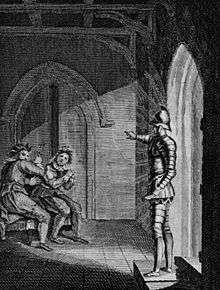The Old English Baron
 Frontispiece illustration to the 1778 edition | |
| Author | Clara Reeve |
|---|---|
| Country | United Kingdom |
| Language | English |
| Genre | Horror; Mystery; Ghost story |
| Published | 1778 |
The Old English Baron is an early Gothic novel by the English author Clara Reeve. It was first published under this title in 1778, although it had anonymously appeared in 1777 under its original name of The Champion of Virtue, before Samuel Richardson's daughter, Mrs Bridgen, had edited it for her. Apart from typographical errors, the revision was trifling.[1]
Miss Reeve noted in the 1778 preface that
"This Story is the literary offspring of The Castle of Otranto, written upon the same plan, with a design to unite the most attractive and interesting circumstances of the ancient Romance and modern Novel, at the same time it assumes a character and manner of its own, that differs from both; it is distinguished by the appellation of a Gothic Story, being a picture of Gothic times and manners."[2]
Originally Miss Reeve presented the story, as Walpole had done before her, as an old manuscript she had merely discovered and transcribed. Under Mrs Bridgen's auspices this fiction was removed from the preface, but more subtle textual references to its authenticity were allowed to remain. These included the claim that the four-year interval was a lacuna in the manuscript, where the original author was supposed to have left off and a "more modern hand" continued the manuscript; there are many subsequent breaches in the narrative where the original was supposed to have been defaced by damp.[3]
The Oxford World's Classics edition notes that it was a major influence in the development of Gothic fiction.[4] It was dramatized in 1799 as Edmond, Orphan of the Castle.[1]
Plot
The story follows the adventures of Sir Philip Harclay, who returns to medieval England to find that Arthur Lord Lovel, the friend of his youth, is dead. His cousin Walter Lord Lovel had succeeded to the estate, and sold the family castle to the Baron, Fitz-Owen. Among the baron's household were his two sons and daughter Emma, several young gentlemen relations being educated with the sons, and Edmund Twyford, the son of a peasant, who had been brought to live with them. When Sir Philip saw him, he took an immediate liking to him, being struck by his resemblance to his lost friend. The Knight proposing to take him into his own family, being childless, Edmund preferred to remain with the Baron, receiving however an assurance that if ever he was in need of it, Sir Philip would renew his offer.
The narrative then oversteps the interval of four years. By his manifestly superior nature and qualities Edmund had attracted the enmity of his benefactor's nephews, and the coldness of Sir Robert, the eldest son. William, his younger brother, is his staunch friend however, and Edmund is in love with the Lady Emma.
Characters
- Sir Phillip Harclay, the Champion of Virtue
- Arthur Lord Lovel, his murdered friend
- Walter Lord Lovel, assassin of the above, and usurper of his lands and titles
- Baron Fitz-Owen, the Old English Baron, brother-in-law of the above
- Robert Fitz-Owen, eldest son of the Baron
- William Fitz-Owen, second son of the Baron, ardent friend of Edmund
- Walter Fitz-Owen, youngest son of the Baron
- Fair Emma, daughter of the Baron, in love with Edmund
- Richard Wenlock, base and vile cousin of the young gentlemen, avid enemy of Edmund
- Edmund Lovel alias Seegrave alias Twyford, posthumous son of Arthur Lord Lovel, raised in obscurity, in love with Emma
- Father Oswald, a priest resident at the castle of Lovel, confidante of Edmund
- Joseph, a faithful elderly servant of the Lovels; devoted to his young master
- Andrew Twyford, a peasant farmer
- Margery Twyford, wife of the above, Edmund's foster mother
Critical reception
Miss Reeve declared in her preface her opinion that such tales should be kept within the bounds of reality, contrasting it unfavourably with Otranto. Walpole remarked in response that the Old Baron was
"So probable, that any trial for murder at the Old Bailey would make a more interesting story."
- ridiculing the concept of a probable ghost-story.
References
- 1 2 "The Literary Gothic: Clara Reeve". Retrieved 2009-03-31.
- ↑ "Project Gutenberg Presents: The Old English Baron". Retrieved 2009-03-31.
- ↑ Reeve, Clara (1777). The Champion of Virtue.
- ↑ "Oxford University Press Book Catalog". Retrieved 2009-03-31.
External links
| Wikisource has original text related to this article: |
- The Old English Baron at Internet Archive
- The Old English Baron at Project Gutenberg
-
 The Old English Baron public domain audiobook at LibriVox
The Old English Baron public domain audiobook at LibriVox